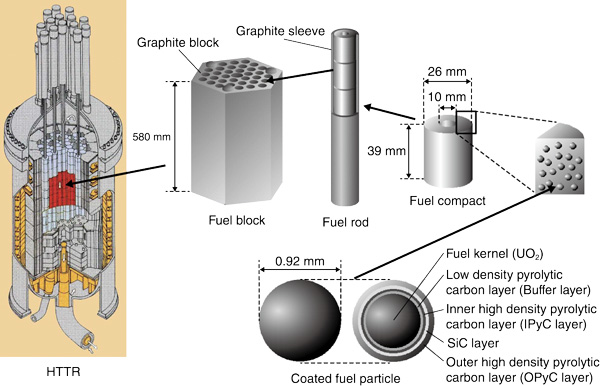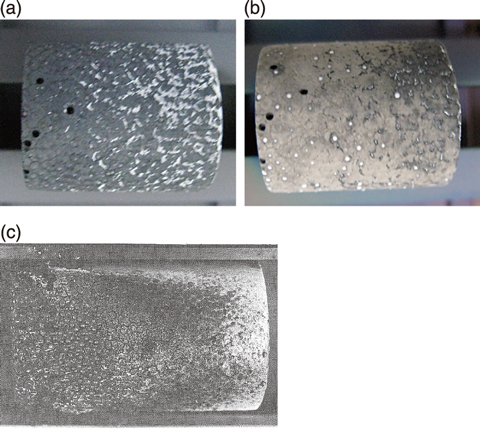
Fig.6-6 Fuel used in HTTR *1

Fig.6-7 Simulated and actual fuel compact
High Temperature Gas-cooled Reactors (HTGRs) are safe next-generation reactors with cores that will not melt. Further safety improvements of the HGTR relies on improve the oxidation resistance of the fuel for the severe oxygen ingress into the core, because almost volume of the cores of the HTGRs consist of graphite (solid C, but not diamond). The graphite is oxidized into CO or CO2 in the oxidation atmosphere at high temperatures.
A small sphere containing fissile materials is coated with layers of ceramics to form a coated fuel particle (CFP) approximately 1 mm in diameter, as shown in Fig.6-6, which are then used in HTGRs. A mixture of CFPs and starting materials of binding material is sintered to form a fuel element. The fuel elements for the High Temperature Engineering Test Reactor (HTTR) of the Japan Atomic Energy Agency (JAEA) are called fuel compacts, of which the binding material is graphite. The binding material is then oxidized into CO or CO2 gas in an oxidation atmosphere at high temperatures. Then the binding material can finally vanish completely in oxidation atmosphere at high temperatures.
An oxidation-resistant fuel element using a binding material of SiC and graphite was developed via collaboration between JAEA and Nuclear Fuel Industries, Ltd. (NFI). SiC is oxidized into a solid oxide, not a gaseous oxide, and does not vanish under high temperature and high oxygen partial pressure. In this study, a simulated fuel element (a simulated fuel compact) with binding material of SiC and graphite was fabricated and an oxidation test was carried out using the simulated fuel compact to investigate whether the oxidation resistance of the fabricated simulated fuel compact is better than that of the fuel compact with graphite binding material or not.
Simulated CFPs (alumina particles) and binding material (Si powder, graphite powder and resin) were molded and sintered into a simulated fuel compact (Fig.6-7(a)), which was then oxidized in He including 20% of O2 at 1673 K for 10 h. The fraction of O2 was set to be similar to air. After oxidation (Fig.6-7(b)), all simulated CFPs were kept in the simulated fuel compact. On the other hand, in a past study, a part of CFPs were loosened from a fuel compact with the graphite binding material by the partially vanishment of the binding material after oxidation in air at 1673 K for 2 h (Fig.6-7(c)). Thus, it was shown that the oxidation resistance of the fabricated simulated fuel compact is better than that of the fuel compact with graphite binding material.
This study was part of the result conducted “Research on advanced fuel element for upgrading safety of high temperature gas-cooled reactors”, and carried out under the project “Center of world intelligence project for nuclear science/technology and human resource development”, sponsored by the Ministry of Education, Culture, Sports, Science and Technology (MEXT), Japan.